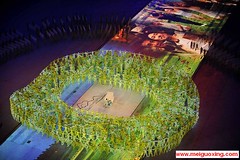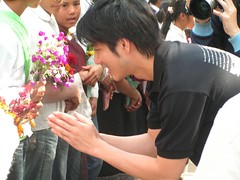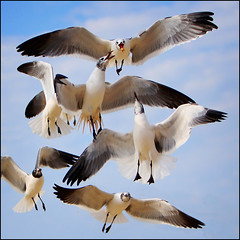Literacy Skills Activities
My eclectic Approaches
Students must learn how to use language processes to explore and construct meaning with the texts , to be literate in Content Classrooms.
Content reading and writing require:
*knowledge of specialized vocabulary
*a wide range of background knowledge
*the use of study and memory techniques
*strategies for reading expository rather than narrative texts
*a high level of monitoring for understanding
*the ability to hold multiple concepts in memory while judging for importance
*knowledge of sources
* the ability to overcome lack of interest in reading and writing to learn
K-W-L, K-W-L + B-K-W-L-Q
K W L
B K W L Q
K-W-L helps readers engage in active thinking.
Students generate what they already know k about the topic, they activate their own background knowledge as well as build background for their peers.
In this process , we are able to assess what we need to teach /help students learn about the concept to be studied.
From the back ground knowledge , students develop lists of questions about the topic for which they would like to find the answers as they read and research w
( Input + 1 ) Srategy:Second language acquisition
When the reading and research is completed, students can revisit their questions to see which have been answered and what they have learned L .
Topic:_______ Write down words that you know about this topic.
When? Why?
How? What?
Who? Where?
Write complete sentences with words above.
Make a paragraph .
______________________________________________________________________________________________________________________________________________________________________________________________________________________________________________________________________________________________________________________________________________________________________________________________________________________________
Skimming and Scanning
*Look quickly and find the most important features and information in a text.
*Prior to the reading the entire text , ask students to find the title, the heading and subheadings, the visuals:chartsgraphs,photographs. Ask them to discuss and decide on what they think this reading will be about.
*Use the Skimming&Scanning form in compiling their questions and comments in the First Impressions colum.Compile facts in fast facts column.
* Determine what they believe will be the important points or questions that will be answered from reading this chapter.
*Discussion of strategies used to quickly determine where and what to read will help solidify students’ skills in Skimming and Scanning.
First impression Fast Facts Final Thoughts
Content Brainstorming
Chapter Title_____________________________
Key Words Heading Subheadings
_________ __________ __________________
_________ __________ __________________
_________ __________ __________________
_________ __________ __________________
_________ __________ __________________
Picture Walk:What predictions can you make about content based on visuals?
Caption: Caption: Caption:
_____________ ______________ ________________
Connections and Questions
What predictions and connections could you make
about what you will learn in the chapter based on above text supports?
________________________________________________________________________________________________________________________________________________________________________________________
What questions could you ask that would focus and guide your reading?
_______________________________________________________________________________________________________________________________________________________________________________________
Content word
Concept Word:______________
Definition: Opposite:
Sketch/picture: Sentence:
Vocabulary Exercise
Definition
vocabulary
Example word Property
Text -to-Text
Compare Contrast_________< >_________
Title
Subtitle
Photograph
Boldfaced Words
Italics
First Paragraph
Last Paragraph
Diagram
Focus Questions
Glossary/Key Words
REAP
Read Encode
Annotate Ponder
R Read the text. Jot down the title and author.
E Encode the text by putting the main ideas in your own words/language.
A Annotate the text by writing a statement that summarizes the important points.
P Ponder the text by thinking and talking about what you learned. Ask yourself why the author wrote the text. What do you think the author hopes you’ll learn?
MORPHOLOGY
NOUN VERB ADJECTIVE ADVERB
________________________________________________________________________________________________________________________________________________________________________________________________________________________________________________________________________________________________________________________________________________________________________________________________________________________________________________
Comprehension Questions
Literal Interpretive&Inferential Evaluative
Look at the picture, What season is it What do you think
what do you see? by looking at the the photographer
picture? was trying to show
you?
What are the people Which emotion do
doing? you think they feel?
What kind of people?
What are the key What do you think
words in the they feel?
paragraph#1? Tell me what they are
feeling?
You see this picture
so you think...
Adapted from :
1.Jo Gusman, New Horizons in Education
2.Janet Allen”Tools for Teaching Content Literacy”
3. NUA conference
You're visiting Banlang's Web Site! I've been teaching for over 30 years. I taught in France and Laos. I started my teaching job in the US in 1976.I taught ESL in Iowa, Indiana and here in Minnesota. Teaching is a life long learning process.We are growing and maturing with it. Not thing is permanent, the only permanent thing is change. "Teaching is more than imparting knowledge,it is inspiring change.Learning is more than absorbing facts,it is acquiring understanding."WAW"
Friday, December 26, 2008
Imovie lesson for students
iMovie Talking Books Lesson Plan
Objectives:
• To enhance the creative writing process by creating a visual talking book.
• To aid the writing process using brainstorming, group and partner discussion, and storyboarding.
• To reinforce the rationale that technology enhances learning in a unique and motivational manner.
Procedure:
1. Discuss with the class, the elements for writing a story.
2. Brainstorm ideas for stories.
3. Allow students to form groups to discuss story problems and solutions.
4. Once students have some original ideas for their stories, divide the class into pairs.
5. Students discuss each other's ideas then collaborate to formulate story ideas for their partner story.
6. Students create a story board - simple stick men drawings - of six or more drawings depicting the important events of their story. Much discussion may take place here as they use pictures to tell their story.
7. Once the rough draft storyboard is complete, the students write their first draft of the story keeping in mind that what they write must match the drawings on their storyboard.
8. The rough draft is proofed and edited, then students draw good copies of their storyboard. Students use pencil crayons, wax crayons, fine tipped black felts, and 9 x 12 white construction paper to complete their drawings.
9. Students then write the goop copy of their story on the back of each of their good copy drawings.
10. The students or the teacher will take digital pictures of the student drawings and place them in a share folder on the school's computer network.
11.
12. Students access their pictures and place them in iPhoto for digital enhancing.
13. Students open iMovie and save their new project to the local hard drive. (iMovies do not work well if the media has to be accessed over a network.)
14. Students go to photos in iMovie and drag their pictures to the iMovie timeline. They set the time for each of their pictures according to how long it takes them to read what they wrote on the back of their pictures.
15. Once the pictures are timed correctly, transitions, the Ken Burns Effect and Titles are added to their movie.
16. Students add sound effects from iMovie and from SoundDogs.com. (To get sounds from the internet, students quit iMovie, go to SoundDogs.com, find appropriated sounds, and save them to their music folder. Then they open iTunes and copy over their sounds. Once the sounds are in iTunes, they are accessible in iMovie.
17. Sound effects are dragged to the sound tracks on the iMovie timeline and students record their voice overs.
18. The projects are saved, burned to a DVD and shared over the internet using QuickTime.
19. Students and teachers celebrate the completion of the project by showing the DVD to the class. (popcorn and drinks are optional)
Objectives:
• To enhance the creative writing process by creating a visual talking book.
• To aid the writing process using brainstorming, group and partner discussion, and storyboarding.
• To reinforce the rationale that technology enhances learning in a unique and motivational manner.
Procedure:
1. Discuss with the class, the elements for writing a story.
2. Brainstorm ideas for stories.
3. Allow students to form groups to discuss story problems and solutions.
4. Once students have some original ideas for their stories, divide the class into pairs.
5. Students discuss each other's ideas then collaborate to formulate story ideas for their partner story.
6. Students create a story board - simple stick men drawings - of six or more drawings depicting the important events of their story. Much discussion may take place here as they use pictures to tell their story.
7. Once the rough draft storyboard is complete, the students write their first draft of the story keeping in mind that what they write must match the drawings on their storyboard.
8. The rough draft is proofed and edited, then students draw good copies of their storyboard. Students use pencil crayons, wax crayons, fine tipped black felts, and 9 x 12 white construction paper to complete their drawings.
9. Students then write the goop copy of their story on the back of each of their good copy drawings.
10. The students or the teacher will take digital pictures of the student drawings and place them in a share folder on the school's computer network.
11.
12. Students access their pictures and place them in iPhoto for digital enhancing.
13. Students open iMovie and save their new project to the local hard drive. (iMovies do not work well if the media has to be accessed over a network.)
14. Students go to photos in iMovie and drag their pictures to the iMovie timeline. They set the time for each of their pictures according to how long it takes them to read what they wrote on the back of their pictures.
15. Once the pictures are timed correctly, transitions, the Ken Burns Effect and Titles are added to their movie.
16. Students add sound effects from iMovie and from SoundDogs.com. (To get sounds from the internet, students quit iMovie, go to SoundDogs.com, find appropriated sounds, and save them to their music folder. Then they open iTunes and copy over their sounds. Once the sounds are in iTunes, they are accessible in iMovie.
17. Sound effects are dragged to the sound tracks on the iMovie timeline and students record their voice overs.
18. The projects are saved, burned to a DVD and shared over the internet using QuickTime.
19. Students and teachers celebrate the completion of the project by showing the DVD to the class. (popcorn and drinks are optional)
Monday, November 24, 2008
SIOP LESSON PLAN ON MATH ADDITION
Lesson Plan for Interaction and Review:
Addition
Background
SIOP
Features
The students have had experiences making stories that tell about things being
added together. They have been studying addition concepts and number sense for
weeks. How the class will try to incorporate language expressions (e.g.,
first, then, together), with the story and write the math equations. Students will
develop concepts for addition by using manipulatives, modeling, and discussing a variety of problem situations.
Supplementary
materials
Key
vocabulary
Materials:
Chart paper with addition poem (Apples), manipulative
pieces, white boards and markers, index cards with equations and answers for matching game that have been cut in half.
Vocabulary:
first, then, together, plus, equals
Content
objectives
Language
objectives
English proficiency levels: Beginners (plus four native English speakers)
Grade: 9-10
Standards: Grade : Mathematics Content Standard ) Show the
meaning of addition (putting together, increasing).
Preparation
Content Objectives: Students will deepen their understanding of the concept of
addition through oral storytelling with the use of manipulatives. They will
connect addition stories to math equations, and write the equations.
Language Objectives: Students will use key vocabulary while telling their
addition stories: first, then, together, plus, and equals. They will state the equation for the story, appropriately.
Supplementary
materials
Key
vocabulary
Link to past
learning
Scaffolding
Materials:
Chart paper with addition poem (Apples), manipulative
pieces, white boards and markers, index cards with equations and answers for matching game that have been cut in half.
Vocabulary:
first, then, together, plus, equals
Motivation
Begin by reading the addition poem, Apples, that students have read previously.
Refer to pictures for added visual support. As a class, read the poem three times.
Focus on key vocabulary.
Techniques for
making
content
concepts clear
Scaffolding
Presentation
Review the objectives and tell students that they will be making addition stories ,and practicing using three important words (first, then, together).
Explain that they will also be writing the equation that goes with the addition story.
Model how to tell an addition story using
the three key vocabulary words. Write the corresponding equation on a white
board. Check for understanding during the modeling by including students in
the story telling. Ask students to tell a story and help with writing the equation.
Practice
Integration of
all 4 lang.
skills
Student to
student
interaction
Feedback
Arrange students in heterogeneous groups of four and give each group one white
board and marker. Tell an addition story and ask student
groups to work together to write the corresponding equation. Only one student
may write, while the other three provide guidance. Have students then pass the
white board and marker to a teammate and repeat the process. Continue until all
group members have had a turn writing an equation. During this time, circulate
and assess student understanding and correct misconceptions among the teams.
Strategies
Emphasizing
key vocab
Scaffolding
Grouping
configurations
support
language
objectives
Application
To help students apply their math knowledge, conduct an inside/outside circle
activity. The students on the inside of the circle hold the white board and the
marker. The students of the outside circle Ask the students
tell an addition story to their inside partner, using the
words first, then, and together. As they finish their story, have the partner write the equation to match the addition story. Once complete, instruct the partners to
exchange materials and begin again. Repeat this process so that the students have
numerous opportunities to practice integrating the content and the language
objectives by telling an addition story.
Opportunities
for interaction
Integration of
4 language
skills
Activity for
students to
apply content
and language
knowledge
Review of
key content
concepts
Review
Distribute half an index card to each student for a mix and match activity. Half of
the students will receive the half of the index card with an equation, while the
other half of the students will receive the half of the index card that has the
equation’s answer. Ask two students to model the trading process by asking,
“What do you have?” and replying, “ I have six plus two” (or whatever the card
says). Next, ask students to reverse the questions, and then have them say, “Let’s
trade.” Conduct the activity and have students begin mixing. Provide enough time
so students have a chance to read many of the different equations and answers.
Say, “Freeze!” to stop the mixing and then tell the students to find their match.
Those that have matched move to sit. while those that are
still seeking their match remain in the center . When all students have found their matches, ask each team to report out their equation and their answer.
Repeat the entire process for additional practice.
Notes:
Scaffold the lesson by having the key words written on the board as a visual cue
for the students’ storytelling. Allow for students to receive support and assistance
from peers during group configurations. Students will participate in whole group
as well as partner work during the lesson. The grouping is heterogeneous by language and ability to allow for optimal interaction. During the circle formation, the inside group should be the students requiring more support, while
the outside circle should be the group that can give assistance. By establishing the groups in this manner, the circles can rotate, while the heterogeneous partnering will remain.
Addition
Background
SIOP
Features
The students have had experiences making stories that tell about things being
added together. They have been studying addition concepts and number sense for
weeks. How the class will try to incorporate language expressions (e.g.,
first, then, together), with the story and write the math equations. Students will
develop concepts for addition by using manipulatives, modeling, and discussing a variety of problem situations.
Supplementary
materials
Key
vocabulary
Materials:
Chart paper with addition poem (Apples), manipulative
pieces, white boards and markers, index cards with equations and answers for matching game that have been cut in half.
Vocabulary:
first, then, together, plus, equals
Content
objectives
Language
objectives
English proficiency levels: Beginners (plus four native English speakers)
Grade: 9-10
Standards: Grade : Mathematics Content Standard ) Show the
meaning of addition (putting together, increasing).
Preparation
Content Objectives: Students will deepen their understanding of the concept of
addition through oral storytelling with the use of manipulatives. They will
connect addition stories to math equations, and write the equations.
Language Objectives: Students will use key vocabulary while telling their
addition stories: first, then, together, plus, and equals. They will state the equation for the story, appropriately.
Supplementary
materials
Key
vocabulary
Link to past
learning
Scaffolding
Materials:
Chart paper with addition poem (Apples), manipulative
pieces, white boards and markers, index cards with equations and answers for matching game that have been cut in half.
Vocabulary:
first, then, together, plus, equals
Motivation
Begin by reading the addition poem, Apples, that students have read previously.
Refer to pictures for added visual support. As a class, read the poem three times.
Focus on key vocabulary.
Techniques for
making
content
concepts clear
Scaffolding
Presentation
Review the objectives and tell students that they will be making addition stories ,and practicing using three important words (first, then, together).
Explain that they will also be writing the equation that goes with the addition story.
Model how to tell an addition story using
the three key vocabulary words. Write the corresponding equation on a white
board. Check for understanding during the modeling by including students in
the story telling. Ask students to tell a story and help with writing the equation.
Practice
Integration of
all 4 lang.
skills
Student to
student
interaction
Feedback
Arrange students in heterogeneous groups of four and give each group one white
board and marker. Tell an addition story and ask student
groups to work together to write the corresponding equation. Only one student
may write, while the other three provide guidance. Have students then pass the
white board and marker to a teammate and repeat the process. Continue until all
group members have had a turn writing an equation. During this time, circulate
and assess student understanding and correct misconceptions among the teams.
Strategies
Emphasizing
key vocab
Scaffolding
Grouping
configurations
support
language
objectives
Application
To help students apply their math knowledge, conduct an inside/outside circle
activity. The students on the inside of the circle hold the white board and the
marker. The students of the outside circle Ask the students
tell an addition story to their inside partner, using the
words first, then, and together. As they finish their story, have the partner write the equation to match the addition story. Once complete, instruct the partners to
exchange materials and begin again. Repeat this process so that the students have
numerous opportunities to practice integrating the content and the language
objectives by telling an addition story.
Opportunities
for interaction
Integration of
4 language
skills
Activity for
students to
apply content
and language
knowledge
Review of
key content
concepts
Review
Distribute half an index card to each student for a mix and match activity. Half of
the students will receive the half of the index card with an equation, while the
other half of the students will receive the half of the index card that has the
equation’s answer. Ask two students to model the trading process by asking,
“What do you have?” and replying, “ I have six plus two” (or whatever the card
says). Next, ask students to reverse the questions, and then have them say, “Let’s
trade.” Conduct the activity and have students begin mixing. Provide enough time
so students have a chance to read many of the different equations and answers.
Say, “Freeze!” to stop the mixing and then tell the students to find their match.
Those that have matched move to sit. while those that are
still seeking their match remain in the center . When all students have found their matches, ask each team to report out their equation and their answer.
Repeat the entire process for additional practice.
Notes:
Scaffold the lesson by having the key words written on the board as a visual cue
for the students’ storytelling. Allow for students to receive support and assistance
from peers during group configurations. Students will participate in whole group
as well as partner work during the lesson. The grouping is heterogeneous by language and ability to allow for optimal interaction. During the circle formation, the inside group should be the students requiring more support, while
the outside circle should be the group that can give assistance. By establishing the groups in this manner, the circles can rotate, while the heterogeneous partnering will remain.
Monday, August 11, 2008
Sunday, August 10, 2008
Very special flower that bloom @ night only!IMG_0317
This is my favorite flower! I grow many of them myself. I love them.They are so fragrant, but its bloom last for only 24 hours.
Pianist Lang Lang performs during 2008 Beijing Olympics Opening Ceremony at the Bird's Nest Stadium

Pianist Lang Lang performs during 2008 Beijing Olympics Opening Ceremony at the Bird's Nest Stadium
Originally uploaded by Meiguoxing
Fireworks explode over the Beijing National Stadium - Bird’s Nest for the opening ceremony of the Beijing 2008 Olympic Games

Fireworks explode over the Beijing National Stadium - Bird’s Nest for the opening ceremony of the Beijing 2008 Olympic Games
Originally uploaded by Meiguoxing
Sunday, April 13, 2008
To those who are interested in SoutEast Asia studies!temple guard
Check out these flick photos and captions by shapesshift. A picture is worth a thousand words! They are good for your students and your-self.
Happy Lao Buddhist New Year to u all !
Happy New Year to you all : my relatives, friends, colleagues, and instructors!
Monday, March 24, 2008
Creating Compassionate Classroon
Let’s learn more and practice of nonviolent communication!
Visit these sites: www.cnvc.org,www.tcnvc.org,www.nvctraining.com
Participate in a training with Marshall Rosenberg www.cnvc.org/mrsched.htm
This winter, I truly and greatly enjoyed the interactive workshop class at the MFT. There were 10 sessions of 2 hours each. Four two hours class, I did not feel that I was too long at all. Instead, I felt the session went by too fast each day. Class participants actually and actively got to practice how to converse with a classmate. Dealing with issues, has something to do with the UNIVERSAL HUMAN NEEDS, FEELINGS when NEEDS are satisfied, and also the FELINGS when NEEDS are not met. We must understand these 3 important things to understand and communicate better with others.
We were exploring how heightened emotional intelligence increases student achievement and restores the sweetness to teaching. We practiced the skills of compassionate communication, as developed by Marshall Rosenberg. I personally, did try to use these skills with my own students in an effort to help my students feel more connected with me, and they them-selves connected with each other. I wanted my students to get more engaged and enthusiastic about learning.
How the NVC impacted my students, my relationship with my students and my role as a teacher?
1. My students were able to practice developing skills through activities and games I took from the book “The Compassionate Classroom” by Sura Hart and Victoria Kindle Hodson.
2. My relationship with my students is better while it was pretty good before.
3. My role as a teacher is to continuously searching for improvement with my teaching, the two ways communication .One can be good, but why not better and even best.
The principles of NVC are basically the followings:
*Aware of our own and others feeling and needs, it is OK for teachers to express their anger fully and wholeheartedly in classroom. NVC does not encourage us to ignore squash or swallow anger.
*There is nothing another person can do that can make us angry.
*It is how we look at situations that creates our anger, not the stimulus itself. The cause of our anger lies in our thinking and our judgments.
*Killing people is too superficial. Any kind of killing, blaming of other people, is a very superficial expression of our anger.
*Anger is a result of life alienating thinking that is disconnected from needs. It indicates that we have moved up to our head to analyze and judge somebody, rather than focus on which of our needs are not getting met.
* All violence is the result of people tricking themselves into believing that their pain derives from other people and that consequently those people deserve to be punished.
*NVC stresses that it is dangerous to think of anger as something to be repressed or bad. It shows us how to use anger as an alarm that tells us we are thinking in ways that are not likely to get our needs met.
* In addressing anger Marshall recommends connecting emphatically with our own needs and those of others. We can do this by consciously replacing the , “ I am angry because they…” with “I am angry because I am needing…”
*What obstacles do I face implementing NVC?
Not much, but time to practice with my students is needed . I already have an established curriculum for my site.
*Do I like the Books?
Indeed I do like the books. Anyone who has not have a chance to read or skim them should check them out .What I like the about “The Compassionate Classroom” was that I was able to use the tools provided in section II of the book for creating my own compassionate classroom.
The second book that like to keep and reuse as my future resource is “Life-Enriching Education” Nonviolent Communication Helps Schools Improve Performance, Reduce Conflict, and Enhance Relationship by MarshallB.Rosenberg,Ph.D.
Working with diverse students who came from so many different background , teacher should learn to be prepared to meet their needs, without effective communication tools ,we may face misunderstanding and frustration sometimes.
* Lastly my reflection on books and Collegial feedbacks I had from the classroom sessions, have been A very educational, helpful and a worthwhile experience for me.
Visit these sites: www.cnvc.org,www.tcnvc.org,www.nvctraining.com
Participate in a training with Marshall Rosenberg www.cnvc.org/mrsched.htm
This winter, I truly and greatly enjoyed the interactive workshop class at the MFT. There were 10 sessions of 2 hours each. Four two hours class, I did not feel that I was too long at all. Instead, I felt the session went by too fast each day. Class participants actually and actively got to practice how to converse with a classmate. Dealing with issues, has something to do with the UNIVERSAL HUMAN NEEDS, FEELINGS when NEEDS are satisfied, and also the FELINGS when NEEDS are not met. We must understand these 3 important things to understand and communicate better with others.
We were exploring how heightened emotional intelligence increases student achievement and restores the sweetness to teaching. We practiced the skills of compassionate communication, as developed by Marshall Rosenberg. I personally, did try to use these skills with my own students in an effort to help my students feel more connected with me, and they them-selves connected with each other. I wanted my students to get more engaged and enthusiastic about learning.
How the NVC impacted my students, my relationship with my students and my role as a teacher?
1. My students were able to practice developing skills through activities and games I took from the book “The Compassionate Classroom” by Sura Hart and Victoria Kindle Hodson.
2. My relationship with my students is better while it was pretty good before.
3. My role as a teacher is to continuously searching for improvement with my teaching, the two ways communication .One can be good, but why not better and even best.
The principles of NVC are basically the followings:
*Aware of our own and others feeling and needs, it is OK for teachers to express their anger fully and wholeheartedly in classroom. NVC does not encourage us to ignore squash or swallow anger.
*There is nothing another person can do that can make us angry.
*It is how we look at situations that creates our anger, not the stimulus itself. The cause of our anger lies in our thinking and our judgments.
*Killing people is too superficial. Any kind of killing, blaming of other people, is a very superficial expression of our anger.
*Anger is a result of life alienating thinking that is disconnected from needs. It indicates that we have moved up to our head to analyze and judge somebody, rather than focus on which of our needs are not getting met.
* All violence is the result of people tricking themselves into believing that their pain derives from other people and that consequently those people deserve to be punished.
*NVC stresses that it is dangerous to think of anger as something to be repressed or bad. It shows us how to use anger as an alarm that tells us we are thinking in ways that are not likely to get our needs met.
* In addressing anger Marshall recommends connecting emphatically with our own needs and those of others. We can do this by consciously replacing the , “ I am angry because they…” with “I am angry because I am needing…”
*What obstacles do I face implementing NVC?
Not much, but time to practice with my students is needed . I already have an established curriculum for my site.
*Do I like the Books?
Indeed I do like the books. Anyone who has not have a chance to read or skim them should check them out .What I like the about “The Compassionate Classroom” was that I was able to use the tools provided in section II of the book for creating my own compassionate classroom.
The second book that like to keep and reuse as my future resource is “Life-Enriching Education” Nonviolent Communication Helps Schools Improve Performance, Reduce Conflict, and Enhance Relationship by MarshallB.Rosenberg,Ph.D.
Working with diverse students who came from so many different background , teacher should learn to be prepared to meet their needs, without effective communication tools ,we may face misunderstanding and frustration sometimes.
* Lastly my reflection on books and Collegial feedbacks I had from the classroom sessions, have been A very educational, helpful and a worthwhile experience for me.
Wednesday, March 5, 2008
Mill City Museum
It was a very interesting, fun and educational field trip that we all from Wellstone High did yesterday!
Our whole school went together. Terry asked me to take some pictures from the site. I took lots of fun activities that our students learned there.
Our whole school went together. Terry asked me to take some pictures from the site. I took lots of fun activities that our students learned there.
Sunday, March 2, 2008
Lunar Eclipse 8/28/07 on Vimeo
I read Terry's post about the lunar eclipse. I like to watch it.There was an eclipe last month. I was watching it in the sky with my daughter LELA all night till it was over.The morning of the following day ,I went to work , my students talked about the eclipse too. But they had their own version of understanding about the elipse.I used the TeacherTube to show a short video clip about the elipses to my students , by ladyringo and the total eclipse by DBean 67770. I like the one that Terry shared with us more. Thank you much Terry!
Monday, February 25, 2008
Working with early Interediate ESL students
Working with early Intermediate Level ESL
Teacher should:
- Assist students to actively developing receptive vocabulary.
- Promote students to Produce one & two- word answers to short sentences, and make them recite and repeat poems, songs, and chants.
- Students can retell simple stories using pictures and objects, and can engage in dialogues, interviews, or role-plays.
*Provide opportunities for contextually supported activities
*Model processes expected of students while verbally guiding students through tasks
*Use scaffolding techniques through out lessons, assisting and supporting
student comprehension
*Expose students to patterned or predictable books
*Provide opportunities for expression in speech and print for a variety of purposes and audiences
*Structure group discussion
*Provide some real texts
*Provide opportunities to create oral and written narratives
*Structure a variety of realistic writing experiences and include opportunities for journal writing, student-authored stories . and language experience activities.
*Use higher level questioning techniques to elicit generative responses
(Accountable Talk,I FL)
***Use data from results of classroom activities & assignments to determine what to teach next.
Teacher should:
- Assist students to actively developing receptive vocabulary.
- Promote students to Produce one & two- word answers to short sentences, and make them recite and repeat poems, songs, and chants.
- Students can retell simple stories using pictures and objects, and can engage in dialogues, interviews, or role-plays.
*Provide opportunities for contextually supported activities
*Model processes expected of students while verbally guiding students through tasks
*Use scaffolding techniques through out lessons, assisting and supporting
student comprehension
*Expose students to patterned or predictable books
*Provide opportunities for expression in speech and print for a variety of purposes and audiences
*Structure group discussion
*Provide some real texts
*Provide opportunities to create oral and written narratives
*Structure a variety of realistic writing experiences and include opportunities for journal writing, student-authored stories . and language experience activities.
*Use higher level questioning techniques to elicit generative responses
(Accountable Talk,I FL)
***Use data from results of classroom activities & assignments to determine what to teach next.
Thursday, February 21, 2008
Exploring Teacher tube
When I spent sometimes watching and listening to teacher tube, I found one talking about"Why let our students blog?" I read the followings answers from many teachers:
for ownership, for sharing, for collabaration, for discussion, for empowerment, for interaction, for aprticipation, for motivation, for engagement, for CONVERSATION, for creativity, for excitemnent, for REFLECTION , for blogging to LEARN, to extend the wall of classroom, to give students a learning environment and for writing to learn. Most students are very young on the video. Check it out, www.teachertube.com
At first , I was looking for plants & and animals video clips for my ESL Science class then I found someone talking about student blogging.
for ownership, for sharing, for collabaration, for discussion, for empowerment, for interaction, for aprticipation, for motivation, for engagement, for CONVERSATION, for creativity, for excitemnent, for REFLECTION , for blogging to LEARN, to extend the wall of classroom, to give students a learning environment and for writing to learn. Most students are very young on the video. Check it out, www.teachertube.com
At first , I was looking for plants & and animals video clips for my ESL Science class then I found someone talking about student blogging.
Wednesday, February 20, 2008
The Center of Attention/Differentiated Instruction
I'm posting this teaching strategy for my student teacher.Birds are flying different ways too so our students them-selves learn at different pace.
Beginning Preproduction
-Simple repeated amounts of English instruction
-Rely on visual and other clues for understanding
-Students may illustrate characters, objects, and actions to convey meaning.
*Provide opportunities for active listening , incorporating props, visuals aids, and real objects into presentations
*pair or group students with more proficient speakers of English
*Conduct shared and guided reading that incorporate prior knowledge and involve the use of visual and graphic supports
*Use and involve students in physical movement and expression
*Involve students in literacy activities and provide students with exposure to written English
* Have students label and manipulate real objects and photographs or illustrations
*Pause during lessons to allow students to process and reflect on the information they are learning.
Source:Hampton Brown
Beginning Preproduction
-Simple repeated amounts of English instruction
-Rely on visual and other clues for understanding
-Students may illustrate characters, objects, and actions to convey meaning.
*Provide opportunities for active listening , incorporating props, visuals aids, and real objects into presentations
*pair or group students with more proficient speakers of English
*Conduct shared and guided reading that incorporate prior knowledge and involve the use of visual and graphic supports
*Use and involve students in physical movement and expression
*Involve students in literacy activities and provide students with exposure to written English
* Have students label and manipulate real objects and photographs or illustrations
*Pause during lessons to allow students to process and reflect on the information they are learning.
Source:Hampton Brown
Interesting SIOP website for teachers who work with ELL/ESL students.
Even though one may have been trained for SIOP strategies from Hamline University, it is good idea to refresh our teaching skills. Visit this website, I found it very useful, and I found more tools then I learned SIOP sometimes ago. Strategy of teaching Content Subjects to ELL students.www.siopinstitude.net
Wednesday, February 6, 2008
Thing #32 WIKI /My cutest cat was gone!
When I use WIKI , I associate it to thing #10.
There are many complicated laws about copyright.
when I applied my thing# 10 in my classroom ESL L2, I used the copyright cartoon video with my students."copyright mystery".They seemed to understand .I went to www.gov./teachers.org
At the beginning I only used wiki as my dictionary later on I use it for many purposes.For example laws & copyright things.
There are many complicated laws about copyright.
when I applied my thing# 10 in my classroom ESL L2, I used the copyright cartoon video with my students."copyright mystery".They seemed to understand .I went to www.gov./teachers.org
At the beginning I only used wiki as my dictionary later on I use it for many purposes.For example laws & copyright things.
Monday, January 7, 2008
Thing 27. Customize My Home Page
I was trying to consolidate all my interest in one spot by customizing my home page. I divided the page into three parts. On the left ,I displayed the links that are relating to my teaching , and goods books for my new comers students.I have blog translation service in many languages. My profile and my archive. On the right are my blogs.At the bottom page are the links to 'youtube ' and slide shows of some interesting pictures.
Sunday, January 6, 2008
Sydney 2008 New Year Fireworks 1
Happy New Year to All @ MILI and Minneapolis Public School!
Especially to students of Information Literacy & their instructor!
Long Live, Peace, Success, and Joy!
Especially to students of Information Literacy & their instructor!
Long Live, Peace, Success, and Joy!
Wednesday, January 2, 2008
Today I travel to Laos via"Flickr"
With 'flickr" one can really enjoy the site seeing. Many people are willing to share their favorite photos that you can see. I actually feel like I 'm in my own country of Laos when I spend time looking at several pictures from Laos, my home town.
This is one of the many pictures that I looked at. In the past I only used google image when I worked with my students. Flickr pictures from yahoo are also owesome!
This is one of the many pictures that I looked at. In the past I only used google image when I worked with my students. Flickr pictures from yahoo are also owesome!
Subscribe to:
Posts (Atom)











